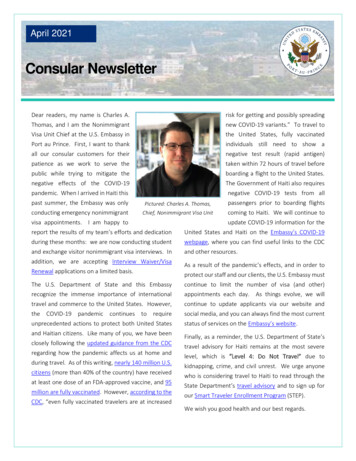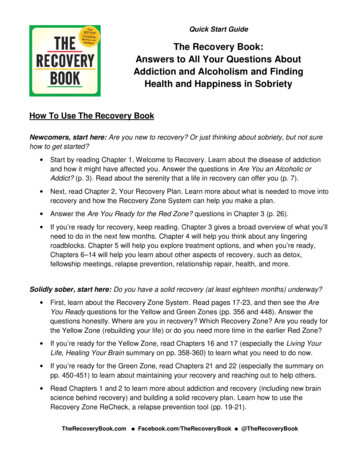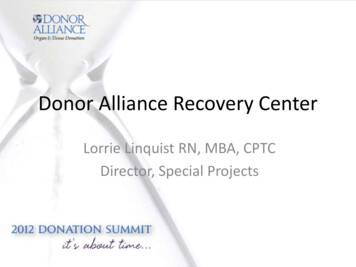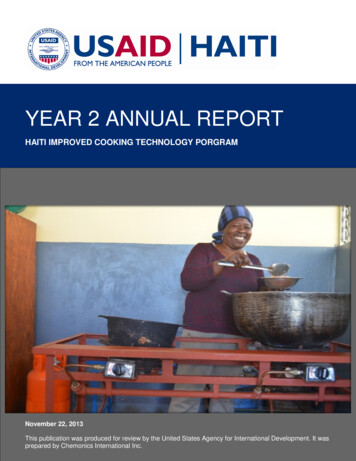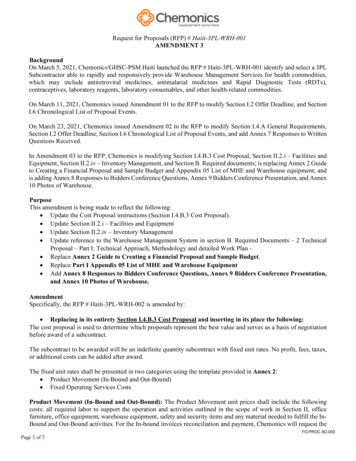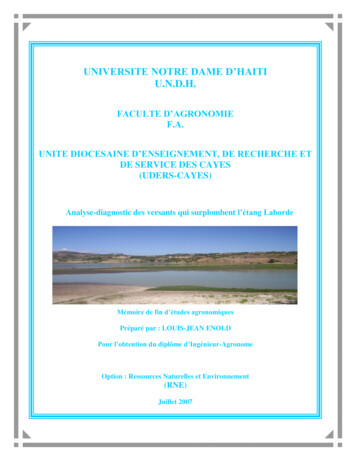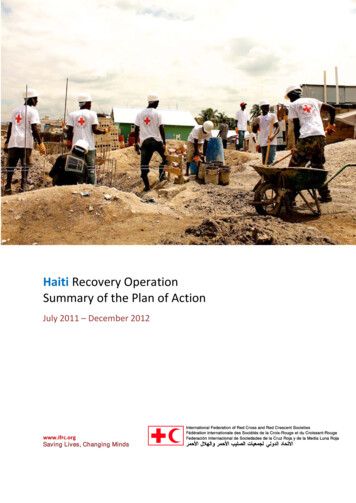
Transcription
Haiti Recovery OperationSummary of the Plan of ActionJuly 2011 – December 2012www.ifrc.orgSaving Lives, Changing Minds
International Federation of Red Cross and Red Crescent SocietiesHaiti Recovery Operation Plan of Action: 2011-2012Table of ContentsAcronyms and Abbreviations3Executive Summary4Background, Context and Rationale6Summary of recovery context6Summary of planning7Summary of IFRC recovery strategy9IFRC results to date9How the Plan of Action is organized. The Pillars Then and Now10Summary of Expected Results12Pillar One: the Recovery Operation14Integrated Neighbourhood Approach (INA) programme15Stand-alone recovery programme23Shelter and settlement solutions23Emergency water and sanitation25Water, sanitation and health in Leogane28Relief31Violence prevention32Pillar Two: National Society Development33Support to the Haitian Red Cross strategy 2010-201533Programme focus areas and key results for 2011-201237Health and care37Disaster risk management41Ambulance services43An Enabling Environment: Support to Programmes44Movement coordination44Beneficiary communications45Support services46Communications46Logistics47Human resources48Security48Base camp48Risk management49Appendix: Violence Prevention502
International Federation of Red Cross and Red Crescent SocietiesHaiti Recovery Operation Plan of Action: 2011-2012i.Acronyms and IV and ODPASSAPAWGPHASTPNSPoAPREKADPSPRCRCSOPSphere (Project)SWGT-ShelterWASHUNUNICEFVCAWHO3Conseil d'Administration de la Section Communale / Commune AdministrationCouncilCommunity-based Health and First AidCholera Treatment CentreCholera Treatment UnitNational Directorate of Water and SanitationDisaster Risk ManagementDisaster Risk ReductionGlobal Alliance on HIV and AIDSGender Based ViolenceGeographic Information SystemHuman Immunodeficiency Virus and Acquired Immunodeficiency SyndromeHaitian Red CrossInter-Agency Standing CommitteeInternally Displaced PersonInternational Federation of Red Cross and Red Crescent SocietiesIntegrated Neighbourhood ApproachInternational Organization for MigrationUnited Nations Stabilization Mission in HaitiMaternal, Newborn and Child HealthMovement Coordination FrameworkMinistry of Public Health and the PopulationNon Governmental OrganizationUnited Nations Office for the Coordination of Humanitarian AffairsOrganizational DevelopmentParticipatory Approach for Safe Shelter AwarenessPerformance and Accountability Working GroupParticipatory Hygiene and Sanitation TransformationPartner National Society/iesPlan of ActionPort-au-Prince Neighbourhood Housing Reconstruction ProjectPsychosocial Support ProgrammeRed Cross and Red Crescent (used interchangeably with IFRC)Standard Operating ProceduresHumanitarian Charter and Minimum Standards in Humanitarian ResponseSpecific Working GroupsTransitional shelterWater, sanitation and hygiene promotionUnited NationsUnited Nations Children’s FundVulnerability and capacity assessmentWorld Health Organization
International Federation of Red Cross and Red Crescent SocietiesHaiti Recovery Operation Plan of Action: 2011-2012ii.Executive SummaryIt is eighteen months since the earthquake of 12 January 2010 devastated much of Haiti’s capital,Port-au-Prince, and nearby localities. An immediate and extensive response was launched by RedCross and Red Crescent Societies, the United Nations and hundreds of national and international nongovernmental organizations. The Red Cross and Red Crescent response was developed in support ofthe strategic plans of both the Haitian Red Cross (HRC) and the Government of Haiti, serving theimmediate humanitarian needs and longer term recovery inputs for the affected population.The collective recovery operation is progressing and results include provision of 100,920 sheltersolutions at 31 July 2011, of which 15,268 have come from International Federation and its partners.The number of internally displaced persons’ (IDP) sites has reduced from approximately 1,500 in July2010 to around 1,000 in May 2011. Challenges and constraints include an uncertain politicalenvironment, logistical complexities of working in the densely populated city of Port-au-Prince, apopulation of some 600,000 people still living in camps in and around Port-au-Prince, continuingdisaster events including the annual hurricane season, and the unexpected cholera epidemic ofOctober 2010 that is expected to remain in Haiti for years to come.This revised Plan of Action follows a series of actions that commenced with the release of theRevised Preliminary Appeal for the Haiti earthquake of January 2010 for 105 million Swiss francs, andan operations update including a revised budget for 218 million Swiss francs issued in early February2010. A Red Cross Red Crescent Plan of Action was developed based on assessments undertaken bythe Red Cross and Red Crescent and other actors, the strategic plan of the Haitian Red Cross and theGovernment of Haiti’s Action Plan for National Recovery and Development of Haiti. The IFRCsecretariat’s own Plan of Action was released in September 2010 reflecting the structure of theFederation-wide Plan of Action and operationalizing the secretariat’s commitments. Results againstthe secretariat’s Plan of Action for the period 12 January 2010 to 30 June 2011 are available in theHaiti Earthquake Consolidated Report of early November 2011.The Federation-Wide Strategic Framework for Haiti was finalized in March 2011 and was developedto maximize the impact of the International Federation of Red Cross and Red Crescent Societies inHaiti. The Framework harmonizes the work of the membership under a common vision and strategicdirection. This initiative follows the direction of Strategy 2020, which affirms the Federation’sresolve to do more, do better and to reach further through a harmonized Federation-wide approachto planning, performance management and accountability.The IFRC recovery strategy follows the Federation-wide Strategic Framework and focuses on threeareas: (1) responsible exit from camps and other emergency interventions; (2) scale-up of theIntegrated Neighbourhood Approach (INA) while meeting previous recovery commitments bothwithin and outside of Port-au-Prince; and (3) support Haitian Red Cross development.This revised Plan of Action Summary has been developed to clearly articulate IFRC secretariat actionsmoving forward according to the funds available to the IFRC Recovery Operation as at July 2011. Itcovers the period July 2011 through December 2012, and as such, replaces the secretariat’sSeptember 2010 Plan of Action. It continues to use a ‘pillar’ approach but the structure has beensimplified to minimize overlap and duplication found in the three-pillar configuration of the 2010Plan of Action. It also reflects a minimized role for IFRC in HRC core services (Health and Care andDisaster Risk Management) and a more focused involvement of IFRC in integrated recovery.4
International Federation of Red Cross and Red Crescent SocietiesHaiti Recovery Operation Plan of Action: 2011-2012 Pillar One: Earthquake recovery operationPillar Two: National Society development and strategy ImplementationHaitian Red Cross will lead the implementation of Pillar Two, with IFRC continuing to provide supportto HRC on its full strategic plan with increased emphasis on institutional development.The keynote of Pillar One is the implementation of the Integrated Neighbourhood Approach (INA) a holistic strategy that encourages integration of key programmes in targeted neighbourhoods. Thegoal is to increase access to sustained basic services and improved infrastructure through provenparticipatory techniques designed to increase community ownership. There are three overarchingobjectives:1. Shelter, water, sanitation and infrastructure support2. Livelihoods3. Community-based supportIFRC will approach INA in two ways: (1) through coordination and support services to themembership to enable their own INA strategies, and (2) through direct implementation. The INAstrategy and the neighbourhoods in which it is planned to be implemented are detailed in section 2of this Plan of Action.In addition to INA, IFRC will continue programming in shelter solutions, will launch violenceprevention coordination activities, and in Leogane will continue implementing water, sanitation andhealth activities. IFRC will, over the remainder of 2011, exit out of emergency interventions emergency shelter/tarpaulins and other non-food item distributions as well as emergency water andsanitation services. Although camp populations are slowly diminishing, hundreds of thousands willremain in camps for some time, and IFRC will continue to monitor the situation and respond asneeded as and when new needs emerge.Pillar Two is focussed on supporting Strategy 2010 – 2015 of the Haitian Red Cross. The goal is toensure that Haitian Red Cross is a strong and reliable civil sector partner to the government and thepeople of Haiti while scaling up and sustaining key services in the sectors of disaster managementand health by strengthening HRC’s financial, technical and human resource base.Under Pillar Two, the programme focus areas for 2011 to 2012 for which the IFRC secretariat willoffer its support to Haitian Red Cross are (1) Health and Care, (2) Disaster Risk Management, and (3)Ambulance Services. It is intended that core HRC programmes such as health and care and disasterrisk management activities will be represented in the services to be offered in the INA approach.While the IFRC secretariat will assume overall management responsibility for the INA programme(Pillar One), health and care and disaster risk management inputs will continue to be directed byHRC (Pillar Two).The Haitian Red Cross health and care programme has four components, which are implementedaccording to needs analyses:1. Community health, including maternal, newborn and child health2. Emergency health3. Psychosocial support programming4. HIV and AIDS, incorporating a gender-based violence componentThe goal of the disaster risk management programme is to reduce community-level risks anddisaster impacts through enhanced disaster risk management capacity of HRC at local, regional and5
International Federation of Red Cross and Red Crescent SocietiesHaiti Recovery Operation Plan of Action: 2011-2012national levels. HRC’s national role will be further enhanced through political advocacy formainstreaming disaster risk reduction within national development and institutional policies andstrategies and through scaled-up participation in the national system structure at all levels.The HRC ambulance service goal for this period is to strengthen National Society capacity to respondto disasters through its national ambulance service, achieving this through capacity building,resource development, and coordination.The IFRC secretariat has established a supporting structure in Haiti to enable advancement of PillarOne and Pillar Two objectives, as well as the operational interests of Partner National Societiesactive in Haiti; this is discussed in part three of this plan. Key functions include MovementCoordination, Beneficiary Communications, and the supporting services of Communications,Logistics, Security, Human Resources, Finance and Administration, and Risk Management.Movement Coordination is a key responsibility of the IFRC secretariat to help ensure efficient andeffective outcomes of the relief and recovery portfolio. Movement Coordination capacity has beenstrengthened in 2011 to continue shelter, and include information management, violenceprevention, livelihoods, disaster risk management and water and sanitation coordination functions.Within the IFRC Haiti operation, beneficiary communications supports operational programmes tocommunicate with and be accountable to their beneficiaries, as well as providing the generalpopulation with practical information on topics such as health and weather. In 2011 and 2012 thebeneficiary communications team will focus on continuing to provide Haitians with information suchas preventative health and disaster preparedness advice; support operational teams to make surepeople know about the Red Cross services and projects that affect them, including transition ofservices from camps to communities and the Integrated Neighbourhood Approach (INA); improve 2way communication and accountability; and work closely with the Haitian Red Crosscommunications team to develop sustainability plans for key beneficiary communicationsapproaches and tools.Host NSType ofDisasterTimeframeof PlanDateBudgetJan.2010Dec. 2014Glide numberHaitian RedCrossEarthquakeJuly 2011 –December201229 December2011CHF282,102,385EQ-2010-000009-HTIClick here for detailed budget information and here for the interim financial report January 2010- 30November 20111. Background, Context and Rationalea. Summary of Recovery ContextAs of August 2011, recovery from the 2010 Haiti earthquake is underway; according to IOM datacamp populations have reduced from approximately 1.3 million to around 600,000 1, althoughnumbers are disputed. Collectively, more than 100,920 shelter solutions have been provided by1OCHA Haiti Humanitarian Bulletin (26 July to 18 August 2011)6
International Federation of Red Cross and Red Crescent SocietiesHaiti Recovery Operation Plan of Action: 2011-2012humanitarian actors at end July 2011 (4,246 achieved / 11,697 planned permanent houses, 6,516achieved / 12,803 planned repairs, 90,158 achieved / 112,271 planned t-shelters; of these 15,268have come from the Red Cross Red Crescent and its partners. The number of IDP sites has reducedas well, from approximately 1,500 in July 2010 to around 1,000 in May 2011. While progress hasproceeded more rapidly in Leogane, Jacmel, Petit Goave, Grand Goave among others, improvementswithin Port-au-Prince are also noticeable. Additional rubble has been removed, streets aresomewhat easier to traverse and road repairs are underway in many areas including the new ‘USAID’road heading west out of the city. Camp closures continue around Port-au-Prince, and many formercamps have been cleared and seemingly made ready for development. It should be noted that thereare a range of factors influencing the reduction in camp numbers, which includes people opting toreturn to their place of origin, and as a consequence of forced camp evictions.Earlier this year, Haiti elected a new government. Expectations are high and much has beenpromised by the new Martelly Administration – including free education funded through mobilephone and money transfer taxes. There has also been a plan to close six high profile camps in a shortperiod of time as a precursor to the demobilization of all 1,000 camps. In late June the MartellyAdministration suffered its first setback when the nominee for prime minister, Daniel Rouzier, wasdenied confirmation in the Senate. The UN/MINUSTAH encouraged Parliament and the MartellyAdministration to form a new government quickly so that civil society, external actors and businesscould get on with recovery and work to help support the government’s emerging strategies. While amaster development plan is still lacking, smaller plans for the development of various economiccorridors in Port-au-Prince are under development and plans continue for a housing creditprogramme. As of August 2011, the Prime Ministerial nomination remains unconfirmed and a newgovernment has not been formed.Cholera remains a concern as the epidemic continues. Cholera will remain in Haiti for years to come,and it is a particular concern now due to the ongoing high numbers of displaced persons andchronically poor access to safe water and sanitation. Since the outbreak in mid-October 2010 thegovernment of Haiti and WHO have reported more than 320,000 cases including more than 5,300deaths. As of early June 2011 there were 1,300 patients estimated in the Port-au-Prince CTCs/CTUsand they were operating at full capacity. Surveillance and reporting remains limited throughout thecountry and government staffing of CTCs and CTUs remains a challenge as the government isreportedly unable to pay salaries. A heightened cholera caseload is expected throughout the rainyand storm season.Meteorologists have predicted 9 hurricanes and 17 major storms for the 2011 storm season, and sofar Haiti has felt the effects of hurricanes Emily and Irene, with the Haitian Red Cross responding toflash flooding in Gonaives and Artibonite in August 2011. To date, all 13 HRC branches have receivedcapacity improvements as well as training, and currently 25,000 families are covered by prepositioned stocks throughout the country.b. Summary of PlanningThis revised Plan of Action marks the evolution of operational planning from the inception of theoperation in January 2010. It follows a series of actions that commenced with the release of therevised Haiti earthquake appeal of January 2010 for 105 million Swiss francs, and the updatedappeal for 218 million Swiss francs in February 2010. Also in February 2010 a Red Cross Red CrescentSummit was convened in Montreal, at which a Red Cross Red Crescent Plan of Action was developed.This was based on assessments carried out; the Strategic Plan 2010-2015 of the Haitian Red Crossand its focus upon disaster preparedness and response, health and blood services; the Government7
International Federation of Red Cross and Red Crescent SocietiesHaiti Recovery Operation Plan of Action: 2011-2012of Haiti’s Action Plan for National Recovery and Development of Haiti; and other actors’assessments. The Red Cross Red Crescent Plan of Action of 2010 was structured around three pillars: Pillar One: Earthquake operationPillar Two: Disaster risk reduction and disaster preparednessPillar Three: Strengthening the Haitian Red CrossIn late April 2010, 25 National Societies, the secretariat of the IFRC and the International Committeeof the Red Cross (ICRC) met in New York City. During this meeting, the Red Cross Red Crescent Planof Action was endorsed, and the Haitian Red Cross presented its national strategy.The IFRC Secretariat’s own Plan of Action was released in September 2010, following the samestructure of the Movement-wide Plan of Action and operationalizing the secretariat’s commitments.In March 2011 the Federation-Wide Strategic Framework for Haiti was finalized. The FederationWide Strategic Framework for Haiti seeks to maximize the impact of the International Federation ofRed Cross and Red Crescent Societies in Haiti through the establishment of common strategies thatfurther align resources and efforts. This initiative follows the direction of Strategy 2020, whichaffirms the resolve to do more, do better and to reach further through a harmonized Federationwide approach to planning, performance management and accountability.This revised Plan of Action has been developed to clearly articulate IFRC secretariat actions movingforward according to the funds available to the IFRC Recovery Operation as at July 2011. As such, itreplaces the secretariat’s September 2010 Plan of Action for the period July 2011 to December 2012.Planning for longer term programming to December 2014 is underway and will be developed toreflect forward plans, particularly in regards to National Society development and expansion of theintegrated neighbourhood approach.DATEDOCUMENTJanuary 2010Revised Preliminary Haiti earthquake appeal for 105 million Swiss francs.February 2010Updated Haiti earthquake appeal for CHF 218 million Swiss francs.February 2010Red Cross Red Crescent Summit in Montreal: 2010 Plan of Action isdeveloped.April 2010New York City meeting: Red Cross Red Crescent Plan of Action isendorsed. Haitian Red Cross presents its national strategy.September 2010IFRC secretariat Plan of Action is released.March 2011Federation-Wide Strategic Framework for Haiti is finalized.November 2011Haiti Earthquake Consolidated Report for the period January 2010 to June2011 is published on the web.8
International Federation of Red Cross and Red Crescent SocietiesHaiti Recovery Operation Plan of Action: 2011-2012December 2011 Revised Plan of Action replaces IFRC secretariat Plan of Action ofSeptember 2010.Revised Plan of Action covers the period from July 2011 toDecember 2012 and is accompanied by a revised budget for theperiod January 2010 to December 2014.c. Summary of IFRC Recovery StrategyThe IFRC recovery strategy follows the Federation-wide Strategic Framework and focuses on threeareas:1. Responsible exit from camps and other emergency interventions2. Scale-up the Integrated Neighbourhood Approach while meeting previous recoverycommitments both within and outside of Port-au-Prince.3. Support for Haitian Red Cross National Society DevelopmentOver the remainder of 2011, IFRC will exit out of emergency interventions (emergencyshelter/tarpaulins and other non-food item distributions as well as water and sanitation) and willfocus streamlined capacity on neighbourhood renewal. However, while the camp population isslowly diminishing, hundreds of thousands will remain in camps for some time. IFRC will continue tomonitor the situation and respond as needed as and when new needs emerge.IFRC is currently supporting several PNSs in the integrated neighbourhood approach in addition tofacilitating their own direct implementation in targeted areas. Plans are in place to scale up bothdirect implementation as well as PNS support in INA over the coming 18 months.Finally, support to HRC continues to evolve within the areas of health and ambulance services,disaster risk management and organizational development. New capacity building interventions arebeing tested and activities crucial to the long-term sustainability of HRC services prioritized.d. IFRC Results to DateThe Federation secretariat in Haiti, supported by the Zone and headquarters offices, continues tomake significant progress in earthquake recovery as well as in support to Haitian Red Cross in keystrategic areas. Main achievements of the secretariat operation are available in the 18 months’progress report published on the Federation web site on 2 November 2011.9INDICATORSTOTAL REACHEDHouseholds provided with at least one hygiene kit190,947Households provided with at least one distribution of two tarpaulins157,623Shelter solutions provided to households*5,203
International Federation of Red Cross and Red Crescent SocietiesHaiti Recovery Operation Plan of Action: 2011-2012Latrines installed in 27 camps814Households covered by pre-positioned non-food relief stock25,000Haitian Red Cross branches with improved capacity to respond to disasters13People reached through SMS with key messages related to health, disasterpreparedness and violence prevention1.2 millionPeople reached with psychosocial support *93,484People being provided with daily access to drinking water**[ 219,000- 94,000]People provided with access to sanitation facilities***37,000*Cumulative number from January 2010 to June 2011** Figure as of June 2011. This reflects a downscale of emergency water provision (in January 2011 219,000people were provided with access to drinking water) to more sustainable water provision.**** Sites where IFRC is providing PNS with desludging services are not included.2. How the Plan of Action is organized. The Pillars Then and NowThis current Plan of Action covers the period July 2011 through December 2012. It uses a ‘pillar’approach but the structure has been simplified to minimize overlap and duplication found in theprevious configuration. It also reflects a minimized role for IFRC in HRC core services (health and careand disaster risk management) and a more focused involvement of IFRC in integrated recovery.The Three Pillars Approach THENEarthquakeOperationDisasterPreparednessPillar OnePillar TwoSupport affectedhouseholds with theirimmediate postearthquake needs andhelp them movetowards recoveryIntroducing keycommunity-baseddisaster risk reductionand disasterpreparednessmeasures, bearing inmind the potentialimpact that the rainsand hurricanes canhave on an annualbasis upon this alreadyweakened nationStrengthening theHaitian Red CrossPillar ThreeStrengthenedorganizational capacityto deliver integratedservices with a focuson disaster response,health andorganizationaldevelopment10
International Federation of Red Cross and Red Crescent SocietiesHaiti Recovery Operation Plan of Action: 2011-2012The Two Pillars Approach NOWPillar OneNational SocietyDevelopment and StrategyImplementationFacilitate camp to community through:Pillar TwoEarthquake Recovery Operation1. Integrated NeighbourhoodApproach (INA)Support to Strategy Implementation:2. Shelter Solutions2. Disaster Risk Management3. Transitioning Emergency Water andSanitation3. Ambulance Services4. Transitioning Relief5. Water, sanitation and health inLeogane1. Health & Care4. Compound Development5. Integrated Delegates6. Institutional DevelopmentThe Plan of Action will focus on the two pillars with HRC clearly leading implementation of Pillar 2.IFRC will continue to provide support to HRC on its full strategic plan with an increased emphasis oninstitutional development interventions.IFRC will report on the revised plan of action quarterly. IFRC will take responsibility for the overallreport but HRC will lead the reporting against the results framework for health and care, disaster riskmanagement and ambulance services. The quarterly reports will largely focus on activities andoutputs, although outcomes will be articulated as appropriate; more significant outcomes andpossibly impact will be captured through final evaluations and end of project reports andsummarized in relevant operations updates.The Plan of Action describes the key sector inputs in the recovery operation. The intent of this Planof Action is to present a clear picture of the Haiti Recovery Operation of the secretariat and the keyoutputs to be achieved by end December 2012.11
International Federation of Red Cross and Red Crescent SocietiesHaiti Recovery Operation Plan of Action: 2011-20123. Summary of Expected ResultsFollowing are tables summarizing the expected results across the various programme areas asarticulated in pillars one and two.Global overview of results and targets for the Plan of ActionWATEROverall TargetsKEY RESULTSOVERALLTARGETSIntegrated Neighbourhood ApproachProjectsKEY RESULTSOVERALLTARGETSStand-alone Recovery ProjectsPort-au-PrincemetropolitanareaSupport IFRC shelteractivities with waterand sanitation inputs.2,000householdsCamps in whichIFRC willdiscontinue watertrucking services.66 campsLeoganeSupport Spanish RedCross shelter activitieswith water supplyinputs.2,203householdsProvide access tosafe water supply.4,000householdsSANITATIONOverallTargetsKEY RESULTSOVERALLTARGETSIntegrated NeighbourhoodApproach ProjectsKEY RESULTSOVERALLTARGETSStand-alone Recovery ProjectsPort-au-PrincemetropolitanareaSupport IFRC shelteractivities with waterand sanitationinputs.2,000householdsCamps in which IFRCwill discontinuedesludging services.32 campsLeoganeSupport Spanish RedCross shelteractivities with watersanitation andhygiene promotioninputs.2,200householdsIncrease access tosanitation facilities.2,000households12
International Federation of Red Cross and Red Crescent SocietiesHaiti Recovery Operation Plan of Action: 2011-2012HEALTH 2Overall TargetsKEY RESULTSOVERALLTARGETSIntegrated Neighbourhood ApproachProjectsOVERALLTARGETSStand-alone Recovery ProjectsPort-au-PrincemetropolitanareaSupport INAneighbourhoods withCommunity basedhealth and first-aidtbaTraining HRCvolunteers in keyhealth and careareas1,500volunteersLeoganeCommunity basedhealth and first-aid4,400householdsIncrease awarenessof healthinformation viacommunity-basedhealth and first-aid2,000householdsKEY RESULTSOVERALLTARGETSKEY RESULTSOVERALLTARGETSOTHERSECTORSOverall Targets2KEY RESULTSIntegrated Neighbourhood ApproachProjectsStand-alone Recovery ProjectsRELIEFN/AN/ADistribution oftarpaulins foremergency shelter103,000householdsDISASTER RISKMANAGEMENT 3Support INAneighbourhoods withDRMtbaCommunityvolunteersmobilized andequipped500volunteersThe distinction between INA and Non INA programmes refers to a geographical distinction as activities aresimilar. When the Health component is integrated into others sectors it is called INA and when Health activitiesare implemented in an area where none of the other actors are present it is Non-INA.3For DRM, the logic is the same: the distinction between INA and Non INA programmes refers to ageographical distinction as activities are similar. When the DRM component is integrated to others sectors it iscalled INA and when DRM activities are implemented in an area where none of the other actors are present itis Non-INA.13
International Federation of Red Cross and Red Crescent SocietiesHaiti Recovery Operation Plan of Action: 2011-2012SHELTEROverall TargetsKEY RESULTSOVERALLTARGETSIntegrated Neighbourhood LIHOODSOverall TargetsProvide householdswith improved accessto shelter andinfrastructureupgrades inconsultation with thecommunity.2,000householdsKEY RESULTSKEY RESULTSOVERALLTARGETSStand-alone Recovery ProjectsProvidehouseholds withimproved shelterconditions: Supply andtraining Shelter unitsimplementedby IFRC Alternative SelfShelterSolutions House repairsAt least7,500households3,5951,4052,500OVERALL TARGETSIntegrated Neighbourhood Approach Projects4Port-au-Princemetropolitanarea 500 cash grantUp to 4,000 householdsVocational trainingavailableAll registered beneficiariesAccess to funds for smalland medium enterprises4. Pillar One: the Recovery OperationActivities under Pillar One are organized into two sections, those recovery activities that are part ofthe Integrated Neighbourhood Approach (INA), and those that are to be delivered as part of otherrecovery activities. Shelter and Sheltering Solutions: IFRC s
International Federation of Red Cross and Red Crescent Societies Haiti Recovery Operation Plan of Action: 2011-2012 5 Pillar One: Earthquake recovery operation Pillar Two: National Society development and strategy Implementation Haitian Red Cross will lead the implementation of Pillar Two, with IFRC continuing to provide support

